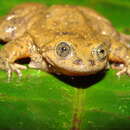en
names in breadcrumbs


Telmatobius yuracare, the Sehuencas water frog, is a threatened species of telmatobid frog that occurs in montane rainforests, cloud forests and Yungas forest at altitudes of 2,000-3,000m asl in the eastern Andes of Bolivia in Chapare Province and Caballero Province (De la Riva 1994). It is an aquatic species, seen mostly at the bottom of streams and ponds, but also on the ground during rains. It breeds in water; the tadpole was described by De la Riva (1994).It is not known from exposed areas outside forest. Individuals are sticky when handled (Köhler 2000).
Telmatobius yuracare is considered vulnerable by the IUCN because it occurs over a small range.It is at risk of habitat destruction due to agriculture, water pollution and logging and also susceptible to Chytridiomycosis (Cortez et al. 2015).
The Sehuencas water frog (Telmatobius yuracare) is a species of frog in the family Telmatobiidae. It is endemic to Bolivia.[1][2] Its natural habitats are subtropical or tropical moist montane forest, rivers, and freshwater marshes. It is threatened by habitat loss.[1] No individuals were encountered in the wild between 2008 and 2019.[3]
Conservation of the Sehuencas water frog has been a focus of the K'ayra Center, run by herpetologist Teresa Camacho Badani at the Museo de Historia Natural Alcide d'Orbigny (MHNC) in Cochabamba.
A single male Sehuencas water frog, nicknamed "Romeo," was collected from the wild in 2009 and housed at the K'ayra Center at the Museo de Historia Natural Alcide d'Orbigny (MHNC).[4] There were fears that Romeo was the last of his kind, an endling. Bolivian conservationists had long been looking for other Sehuencas water frog individuals, particularly females, in hopes of creating a captive breeding program. To raise awareness and money about the plight of the Sehuencas water frog, conservationists from Global Wildlife Conservation[4] and the Bolivian Amphibian Initiative created a profile for Romeo on Match.com, an online dating website.[5] In January 2019, an expedition headed by Badani in a Bolivian cloud forest led to the discovery of five more individuals: three males and two females.[6] The re-discovered frogs will be treated against chytridiomycosis, a fungal disease causing widespread decline of amphibians.[7] After treatment, Romeo will be introduced to a female called Juliet. Despite this, there are concerns that there are too few frogs left in the wild for a sustainable long-term population, and thus captive breeding is considered the best way to restore the species.
The Sehuencas water frog (Telmatobius yuracare) is a species of frog in the family Telmatobiidae. It is endemic to Bolivia. Its natural habitats are subtropical or tropical moist montane forest, rivers, and freshwater marshes. It is threatened by habitat loss. No individuals were encountered in the wild between 2008 and 2019.